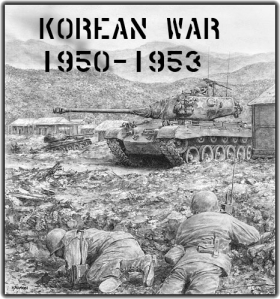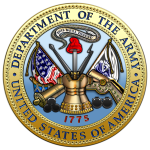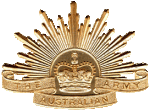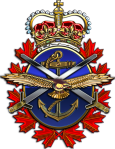Korean War – Final Day (?)
#########################################################################################
27 JULY 1953
In the U.S. Marine report – Hill 119 was attacked once more at 0035 hours by an enemy platoon. Shortly afterwards, Hill 111 was also embroiled in combat with an enemy platoon. After one hour and 20 minutes, the Chinese troops were forced to withdraw. Although the cease-fire was signed at 1000 hours and became effective at 2200 hours, the 1st Korean Marine Corps RCT reported 5 rounds of 82mm mortar landed near Command Outpost Camel.
In the U.S. Naval Report – Task Force 77 expended its major effort on transportation facilities with airfields. The TF-77 aircraft destroyed or badly damaged 23 railroad cars, 11 railroad bridges, one railroad tunnel, 69 buildings, 100 yards of trenches and 9 highway bridges. In addition, 5 airfields were cratered. All hostilities ended at 2200 hours.
From the Airborne 187th RCT – They heard fire coming from Sniper Ridge throughout the night. Just five hours before the cease-fire, the 187th Rakkasans lost one more man – Sgt. Carl Hammer, 22 years old. By morning, everything was eerily quiet. All at once the war was over and by dawn’s light, the men began to police their areas. On 1 August, they were back on the Nebraska Line and building the “Blackjack Bastion” straddling the road to Seoul called the ‘bowling alley’. On 3 October 1954, they boarded the USS General Pope to a welcome home reception at Fort Bragg, NC. The Rakkasans have continued their serve into Vietnam, Desert Storm, The Iraq Campaign and the Afghanistan Campaign.
From the Australian Army, Air Force & Navy – After the ceasefire, the 2 and 3 RAR withdrew from the Hook and sent to the Kansas Line to build new fortifications. They returned home in April and November respectively the following year, with the 1 RAR taking their place, stationed at Gallipoli Camp for 17 months. The 77 Squadron/RAAF remained in South Korea for one year after the ceasefire, during which time Pilot Officer H. Andrews was killed in a mid-air collision. The Australian records show that 44 MIAs are still on their books for Korea. The RAN was to maintain 2 ships in Korean water until 1955: during the tour of HMAS Sydney, Acting Sublieutenants M. Beardsall and J. Clinton were killed in air accidents. The final ship HMAS Condamine departed 9 October 1955.
It appeared quite possible for the first year after the signing of the armistice that war would erupt again, such as, in October 1953 when a communist raid on United Nations forces resulted in the deaths of 4 South Koreans and 2 Americans.
An interesting video for the Canadians and additional Korean information can be located on this site here.
############################################################################
Farewell Salutes –
James J. Alfano – Sun City, AZ; US Army, Korea
Ernest Ralph Carlson – Oamaru, NZ; 2nd NZEF # 6835
Terrance M. Crowe – Franklin Park, IL; USMC, Vietnam, Purple Heart
Earl Doyle – Kelowna, B.C. & St. Lambert, Quebec; RCAF, 438th Squadron, Captain, Sabres & Otters
Ivan A. Frost – Lower Hutt, NZ; RNZAF Flt. Sgt., RAF 75th Squadron # N24215678, WWII
Bernard Moran, Jr. – Washington DC; US Navy, WWII, PTO, USS Pittsburg
Robert Raup – Kansas City, MO & D.C.; US Navy, WWII; Pentagon & Nato civilian service later
Edward Touhy – Chicago, IL; US Navy, WWII
Leslie Venner – Mississauga, Canada; RCNavy, HMCS Waskesiau, WWII
############################################################################
Posted on March 4, 2014, in Korean War, Uncategorized and tagged Airborne, Australia, family history, History, Korea, Marines, Military, Military History, nostalgia, veterans. Bookmark the permalink. 55 Comments.














Was interesting that there are still 44 Australian Mia,s recorded.
Wonder if any steps were ever taken to find out the fate of these diggers.
Ian
LikeLiked by 1 person
I believe I did see something on that. Sadly, of course, they are not expected to be found alive.
LikeLiked by 1 person
Fantastic series!
LikeLike
From a man who bogles the mind with his research that is high praise indeed – Thank You very much.
LikeLike
You are very kind. Thanks.
LikeLike
Not kind – honest.
LikeLike
Sgt. Hammer… I feel so bad for him and his family… I still marvel that while the cease fire was to be at 22:00, the enemy still engaged… What drives people so insane?
LikeLiked by 1 person
Money, power, pride, ignorance, arrogance, blind obedience – take your pick or add more reasons….humans are habitually educated beyond their own intelligence and make very stupid choices repeatedly – I like that one. No, Koji – I don’t really know how they could be driven so totally mad.
LikeLiked by 1 person
When I saw the word “final”, I experienced several feelings, most beginning with “0h no!” I finally was just going to go ahead and ask if your posts were done, and then I read through the replies. So, WHEW! From this reader, and I look forward to where you take us next.
LikeLike
So nice of you to say so! Yes, I’m not going anyway and I’m glad you aren’t leaving either. I didn’t realize the questions I would stir up with the title Final Day ? Oh well, my bad I guess.LOL
LikeLike
We have ‘US Marine Corps’ and ‘US Navy’, but ‘Department of the Army’. What’s with that?
LikeLike
Didn’t realize I had done that, Jacqui. You’ve got a sharp eagle eye.
LikeLike
Your efforts are tireless, GP. Excellent work!
LikeLike
Thank you, I appreciate you saying so, hope you’ll hang around thru the “Intermission” stories (the kind of first hand accounts everyone likes) and then back to WWII.
LikeLike
Love your posts. Always informative and I leave learning something new. If you need new things to write about….well, write about the wrong direction our country has taken and how we are all inevitably headed to the next WW. God help us all.
LikeLike
It’s very sad, but not new, Maddy and I don’t think God has a thing to do with it. Our chaotic, power-hungry state of affairs would get my blood pressure up too high at the political imbeciles that seem to get themselves into offices of power, so I’ll leave that topic for people who can handle it better, like Kevin’s site HERE. I’m glad you’ve enjoyed this series on the Korean War (still a couple of posts to go) but I will once again be going backward to the very start of WWII, making it, still about the Pacific War, but more international. I hope you’ll stick around.
LikeLike
Totally understand you and thanks for sharing that link. Will stick around to read more of your posts and will also continue to put my trust in God as long as I have to live in a world full of broken families, violence, drug addiction, hatred, wars,financial scandals and little love for mankind. It may be the only thing that gives me peace/strength as I watch what unfolds before my eyes.
LikeLike
I know things appear bleak now, they also did when people my age used to have a bomb drill and huddle under our desks to practice for when the Bomb hits – but we’re still here. I hope Kevin was able to help you.
LikeLike
Lots of work on these posts . Thanks again , It’s a great tribute to the troops .
LikeLike
More than welcome! Thanks, Dan. And, I hope you’ll stick around.
LikeLike
As I read this post, I couldn’t help but think just how we seem to have circled back to Cold War tensions recently. Or perhaps they never left and there was just a slight lull.
LikeLike
You and I are on the same page. I’ve often wondered how the Cold War could have ended with all the tension that exists between countries? Thanks for the comment, Trapper, I hope others read this and give their own opinions on it.
LikeLike
I wasn’t surprised that the marines encounter action after the cease fire, taking communication relays into consideration, things like this are bound to occur.
I love that you included the appropriate emblems with each report.
On the Aussies, you reported 44 still MIA, does that mean MIA from this current day, or within the time they were still in Korea?
AND…that video from the last link…AMAZING…I suddenly understand the knee jerk reaction that occurred to cause this conflict (war) to occur. Excellent reference.
LikeLike
I should have been more considerate and added the link where I acquired the information. (many people know I am not very good at doing this – so – I hope it works. This site also includes a complete list of the men.)
http://korean-war.commemoration.gov.au/ceasefire-at-panmunjom/australians-missing-in-action.php
LikeLike
Sad…thanks for the link.
LikeLike
Oh, how I long for peace. But, oh, what we’re going to go through first to get there…. Thanks, GP!
LikeLike
You are so right, Linda. Do you honestly think humans will ever learn this or is power too ingrained in our character?
LikeLike
I just received a box of my grandfather’s things from Korea, including dozens of photographs he took while he was there. (I plan to post them to my blog in the near future.) They are really fantastic, and contain everything from photos of locals, fellow soldiers, the landscape, city buildings…etc. I’d be happy to let you use one or more in the future if you’d like. Cheers!
LikeLike
I certainly want to visit your site and follow that information! Thank you for letting me know about newly acquired treasures!
LikeLike
This has been such an outstanding series and I’ve learned a lot. Visiting the no-man’s land of their demilitarized zone a few years back was chilling. Your posts have added so much to my understanding of that brutal war and where we are today. Great work and thanks.
LikeLike
You are very welcome, Carol; but there are a couple of posts left to go here before the “Intermission” phase and then back to WWII.
LikeLike
Your series has been amazing. What will you do now that you’ve come to end of your story?
LikeLike
Well, first off I’ll be thanking you very much for the compliment! We still have a couple of posts to go on this and then I’ll be filling in with first hand stories, etc. as I organize a more international version of the Pacific War. I hope you’ll continue to drop by.
LikeLike
Highlight more women 😉
LikeLike
I’ll do my best.
LikeLike
Nice rundown of the events of the early 1950s in Korea.
Yes, the tension continues from North Korea, thanks to “Dear Leader”.
LikeLike
ALL our “leaders” need to start getting a grip!
LikeLike
I wonder what Vegas odds are on that happening. Hmm…
LikeLike
An interesting post GP. I also enjoyed the chat between awax1217 and yourself 🙂
LikeLike
Always happy to entertain, Norma. Glad you stopped in!
LikeLike
I’ve enjoyed this series very much. Is there any explanation for the delay until 2200 hours for the truce to become effective? Was it just to give time for the communication to run through channels? The fighting until the last minute thing puzzles me…what’s the point? Or, as some have suggested, did we just put this war on hold?
LikeLike
Basically it is on hold, neither side signed a peace treaty, as will be explained in the next post along with The Big Switch for the POWs.
LikeLike
Would like your take on this. Do you think the North will ever again try to take the south?
LikeLike
Such an action would not surprise me, nor would continued support from China – they know we can’t handle it again.
LikeLike
I had a professor when I went to college years and years ago who predicted that. He said it was only a matter of time. By the way I just wrote a small piece on the Korean conflict in my blog. I would like you to read it and comment on it.
LikeLike
My father, Smitty, did as well, back when us school kids were worrying about Russia and the bomb – he said it will be China vs the US in the next major war.
LikeLike
I remember those days well. The silos in the countryside with nuclear bombs in them. The Cuban Missile Crisis, the domino theory of one country after another going into the Russian Bloc. My real concern now, is cyberspace and the feeling of how compromised we will be when some hacker destroys our banking system and money is in danger. It will be havoc with not a shot fired.
LikeLike
Yikes – forgot about that!
LikeLike
May one day we all forget about those days of worry and fret. Now it seems to be going full circle. Russia again. Wish we would tell Putin to put it in neutral. He is a dangerous ex KGB and has tzar complexes.
LikeLike
In your link, there is this Did you know?…
Land of the Morning Calm
Canadians in Korea 1950 – 1953
Did you know …
The armistice is signed at Panmunjeon on July 27, 1953.
Each Canadian soldier on the Korean front is entitled to one bottle of Japanese Asahi Beer per day.
North Korea has no submarines.
Ships are continually threatened by mines in rivers and harbours.
The PPCLI is Canada’s only battalion in history to win U.S. Presidential Unit Citation for valour.
Troop training in Korea emphasizes hill climbing and instruction in new weapons and radios.
Neither China nor North Korea signed the Geneva Convention of 1949, which binds nations to specific rules of engagement.
Members of No. 54 Transport Company, RCASC build playground for local Korean children.
Canadian naval destroyers’ high-definition navigational radar makes them invaluable for operations in shallow water.
A Canadian infantryman carried 100 rounds of ammunition, 3 grenades, and a pick or shovel.
A Canadian soldier’s kit contained a water bottle and rations for 24 hours.
A Canadian soldier’s kit included a poncho, 2 pair socks, sweater, towel and shaving gear.
Common ailments among troops in winter are colds, influenza, frostbite, and “trench feet.”
Common ailments among troops in summer are heat rashes, infected insect bites, foot problems, and discomfort from poisonous plants.
The Korean peninsula measures almost 1000 km in length and 200 to 300 km in width.
The name Korea comes from “Goryeo”, which was the regime in power on the peninsula between 938 and 1392.
Between 1910 and 1945, the official language of Korea was Japanese.
The 38th Parallel is 50 kilometres north of Seoul.
Human waste was the most common fertilizer on the rice paddies in Korea.
The Korean War is the third deadliest conflict in Canadian history.
North Korea makes up 40 per cent of the Korean peninsula’s land mass.
South Korea makes up 60 per cent of the Korean peninsula’s land mass.
North Korea is home to one third of the Korean peninsula’s total population.
South Korea is home to two thirds of the Korean peninsula’s total population.
South Korea has few natural resources but is rich in agriculture.
North Korea is rich in resources and industry.
Between 10 and 17 August, 1952 torrential rains collapse 150 Canadian bunkers while the Imjin River rises 12 meters above its normal summer level.
North Korean troops at the start of the conflict: 125,000
South Korean troops at the start of the conflict: 143,000
16 countries, including Canada, make up UN forces on front line in Korean War.
Canadians who were injured or missing in action in Korea: 1,235.
Total United Nations’ soldiers killed, injured, captured or reported missing in action: approximately 1 million (840,000 of them South Korean).
Total Communist forces killed, injured, captured or reported missing: approximately 1.5 million (900,000 Chinese, 600,000 North Korean)
United Nations ground forces at peak strength: 932,539.
Communist side numbered an estimated 1.15 million troops, three-quarters of them Chinese.
South Korea lost between 300,000 and 600,000 civilians, while North Korea lost approximately 1 million.
In all, 26,791 Canadian military men and women serve in Korea and in Japan between 1950 and 1953.
HMCS Cayuga’s guns can fire shells at a distance of 15 kilometres.
Second World War veterans made up approximately 45 per cent of Special Force recruits.
The length of a Korean tour of duty is one year.
American armoured vests, also worn by Canadian soldiers, reduce casualties by 30 per cent.
In three years RCAF No. 426 Squadron carries 13,000 personnel and 3 million kilograms of freight and mail.
21 RCAF pilots serve with US Air Force squadrons in Korea.
Flight Lt. Ernest A. Glover is only pilot to receive both Canadian and American Distinguished Flying Cross in Korea.
Peak Canadian Army strength in Korea was 8,123 all ranks.
516 Canadian soldiers died during the Korean War.
484 of the 26,791 Canadian soldiers who enlisted served more than one tour of duty in Korea.
More than one million men in the United States Army served in Korea.
33 Canadians were prisoners of war and all returned home.
60 Canadian Nursing Sisters served in the Korean War.
Major Lionel Gosselin is the most senior Canadian to be killed in action in the Korean War.
Canadian pilot Andrew R. Mackenzie is imprisoned by the Chinese for 2 years for refusing to admit that he was shot down over China rather than North Korea.
The United Nation’s decision to stop the North Korean invasion of South Korea makes it the first international organization in history to vote in favour of using force to push back an aggressor.
Soldiers J. T. Allain, Arthur Baker and J. A. Bellefeuille are the first Canadians to be taken prisoner during the Korean War.
Lieutenant J. J. MacBrien, who joined the US Navy VF-781 fighter squadron, is first Canadian pilot to fly a jet airplane.
Lieutenant H. T. Ross is first Canadian to be injured in the Korean War.
Lt. J. J. MacBrien, RCN, only Canadian naval aviator to experience combat flying in Korea.
Flying Officer Omer Levesque, seconded to the USAF, is first Canadian to take part in an air fight involving two jet airplanes.
Helicopters are first used extensively during the Korean War, proving essential in the retrieval and extraction of wounded UN troops.
Sailors aboard HMCS Cayuga are the first Canadians to engage the enemy.
HMCS Cayuga is the first warship to fly UN flag in Korea.
Private Len Barton is the first decorated Canadian of the Korean War.
The 2nd Battalion, PPCLI is the first Canadian unit to arrive in Korea.
HMCS Cayuga is the first Canadian ship to open fire on an enemy target during the Korean War.
Canadian Prime Minister during the Korean War: Louis Saint-Laurent.
United States Presidents during the Korean War: Harry Truman, followed by Dwight D. Eisenhower.
Leader of the Democratic People’s Republic of Korea (North Korea): Kim Il Sung.
Leader of the Republic of Korea (South Korea): Syngman Rhee.
Soviet leaders during the Korean War: Joseph Stalin, followed by Nikita Krushchev.
Canadian brigade commanders during Korean War: Brigadier John Rockingham, followed by Brigadiers M. P. Bogert, and Jean-Victor Allard.
Commanders-in-chief of UN Command during Korean War: General Douglas MacArthur, followed by Generals Matthew Bunker Ridgway and Mark W. Clark.
LikeLiked by 1 person
I have a similar list myself compiled from a number of resources (and they all vary in the numbers), so I’ll leave this list here as another comparison and for the facts. Glad you enjoyed the link.
LikeLike
The Korean War is still on… It’s only a truce…
LikeLike
Correct – there are a few more posts to go…
LikeLike
Pingback: Korean War Vet Robert Ross (summer a to z Letter V) – In the Zone
Pingback: Remembering Korea | Pacific Paratrooper